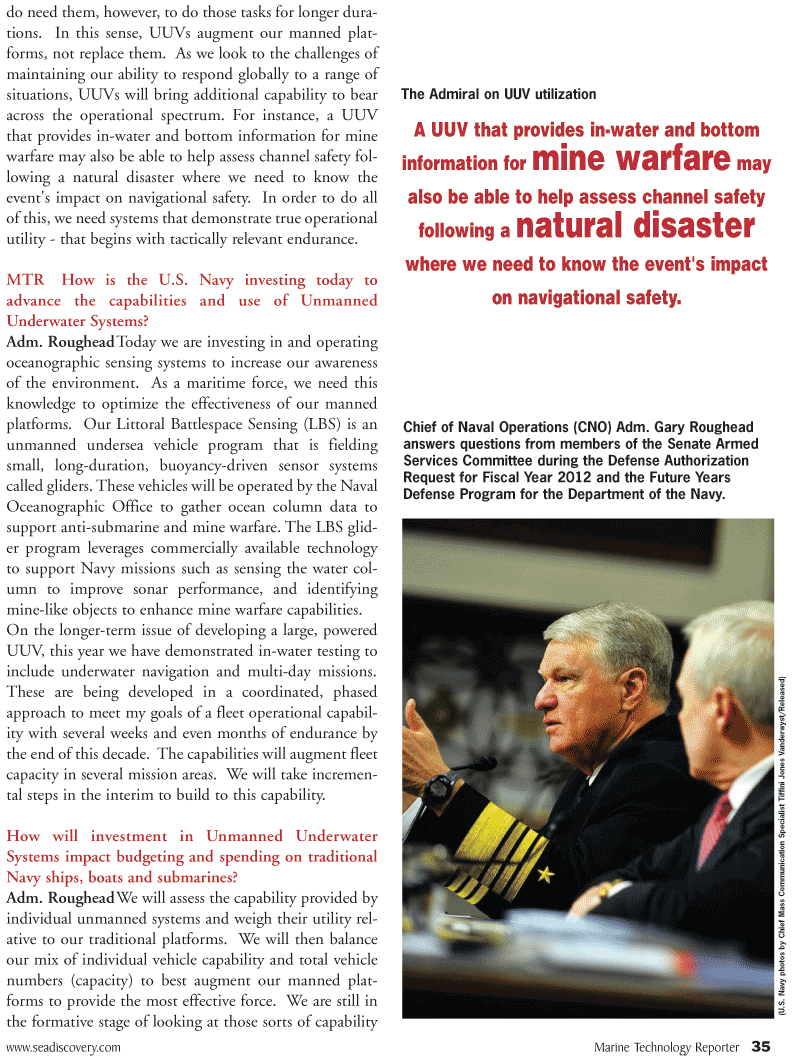
Page 35: of Marine Technology Magazine (June 2011)
Hydrographic Survey
Read this page in Pdf, Flash or Html5 edition of June 2011 Marine Technology Magazine
do need them, however, to do those tasks for longer dura- tions. In this sense, UUVs augment our manned plat- forms, not replace them. As we look to the challenges of maintaining our ability to respond globally to a range of situations, UUVs will bring additional capability to bear across the operational spectrum. For instance, a UUV that provides in-water and bottom information for mine warfare may also be able to help assess channel safety fol- lowing a natural disaster where we need to know the event's impact on navigational safety. In order to do all of this, we need systems that demonstrate true operational utility - that begins with tactically relevant endurance.
MTR How is the U.S. Navy investing today to advance the capabilities and use of Unmanned
Underwater Systems?
Adm. RougheadToday we are investing in and operating oceanographic sensing systems to increase our awareness of the environment. As a maritime force, we need this knowledge to optimize the effectiveness of our manned platforms. Our Littoral Battlespace Sensing (LBS) is an unmanned undersea vehicle program that is fielding small, long-duration, buoyancy-driven sensor systems called gliders. These vehicles will be operated by the Naval
Oceanographic Office to gather ocean column data to support anti-submarine and mine warfare. The LBS glid- er program leverages commercially available technology to support Navy missions such as sensing the water col- umn to improve sonar performance, and identifying mine-like objects to enhance mine warfare capabilities.
On the longer-term issue of developing a large, powered
UUV, this year we have demonstrated in-water testing to include underwater navigation and multi-day missions.
These are being developed in a coordinated, phased approach to meet my goals of a fleet operational capabil- ity with several weeks and even months of endurance by the end of this decade. The capabilities will augment fleet capacity in several mission areas. We will take incremen- tal steps in the interim to build to this capability.
How will investment in Unmanned Underwater
Systems impact budgeting and spending on traditional
Navy ships, boats and submarines?
Adm. RougheadWe will assess the capability provided by individual unmanned systems and weigh their utility rel- ative to our traditional platforms. We will then balance our mix of individual vehicle capability and total vehicle numbers (capacity) to best augment our manned plat- forms to provide the most effective force. We are still in the formative stage of looking at those sorts of capability www.seadiscovery.com Marine Technology Reporter 35
A UUV that provides in-water and bottom information for mine warfare may also be able to help assess channel safety following a natural disaster where we need to know the event's impact on navigational safety.
The Admiral on UUV utilization
Chief of Naval Operations (CNO) Adm. Gary Roughead answers questions from members of the Senate Armed
Services Committee during the Defense Authorization
Request for Fiscal Year 2012 and the Future Years
Defense Program for the Department of the Navy. (U.S. Navy photos by Chief Mass Communication Specialist Tif fini Jones V a nder wyst/Released)

 34
34

 36
36
